In April 2006, a team from the University of Mankato in Minnesota, attending FSAE in Michigan, lost control of their trailer in a cross wind and crashed into opposing traffic. Three students were killed and several others seriously injured. It was the darkest day in FS/FSAE history.

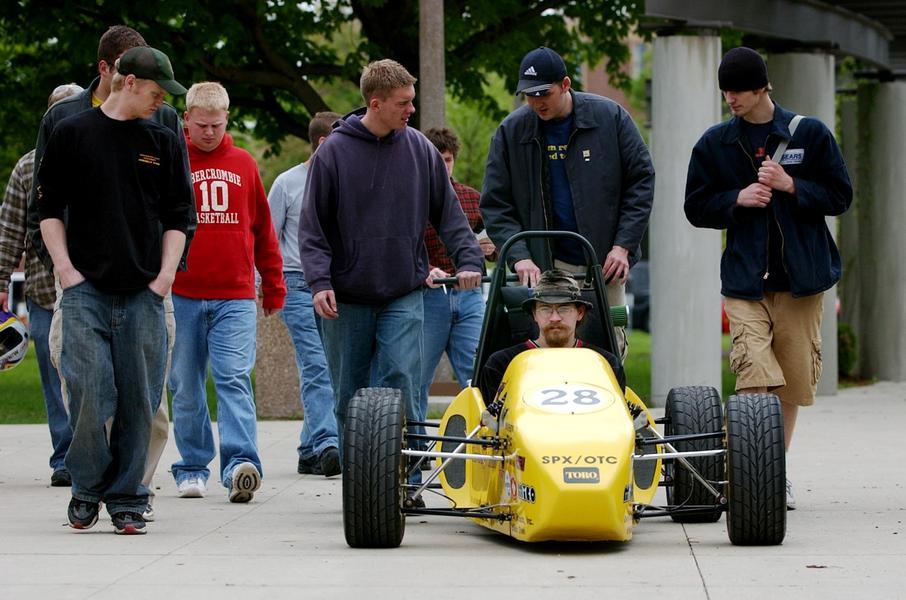
This brought sharply into focus that the most dangerous aspect of Formula Student is often just getting to and from the event.
For some teams, the journey to Hockenheim is long and difficult. The students are excited and usually tired because of the 'burning the midnight oil' that happens before every competition. Add to that the driver may be inexperienced, fuelled with caffeine drinks, The other occupants may well be asleep. The recipe for a disaster!
Many Universities understand all this and take precautions to avoid such dangerous situations developing, but many teams set out unprepared and ill equipped!
So, I thought this issue of the blog might cover trailers and towing.
Note, the recommendations I am making are generic. Local rules may be different in some countries and teams should ensure they meet the legal requirements in any country where they drive!
Trailer Preparation
Perform a safety inspection before the trip. Make sure that...
- The pin securing the ball mount to the receiver is intact.
- The hitch coupler is secured.
- The load equaliser bars are secure with safety clips in place.
- Safety chains are properly attached.
- The electrical plug is properly installed.
A tow vehicle and a trailer form an articulated vehicle which presents an additional set of concerns. The weight and distribution considerations are very important to safe towing. The tow vehicle must be a proper match for the trailer. If the trailer is properly equipped, it can perform safely under a variety of driving conditions. The tow vehicle should also have enough performance to climb mountain grades without excessive loss of speed. Here are two basic types of trailers usually used to tow Formula Student cars...
- Conventional trailers .
- Fifth-wheel trailers.
The major difference between them is the way they are hitched.
Conventional Trailers
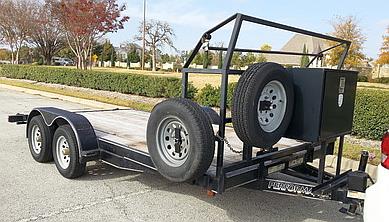
The ball and coupler hitch is used on a wide variety of tow vehicle and trailer combinations. This hitch consists simply of a ball attached to the rear of the tow vehicle and a coupler (socket) at the tip of a tongue or A-frame attached to the front of the trailer. This hitch is commonly used on light car trailers.
A load distributing hitch is used for heavier trailers including those used to carry race cars. These load distributing hitches use special equipment to distribute the tongue load to all axles of the tow vehicle and trailer to help stabilize the tow vehicle.
Here are some terms you should know when discussing hitch adjustment and in evaluating hitch performance:
- Receiver: Hitch platform fitted to the tow vehicle.
- Ball Mount: A removable steel component that fits into the receiver. The hitch ball and spring bars (only on load distributing hitches) are attached to it.
- Sway Control: A device designed to lessen the pivoting motion between tow vehicle and trailer when a ball type hitch is used.
- Coupler: The ball socket at the front of the trailer A-frame that receives the hitch ball.
- Spring Bars: Load-levelling bars used to distribute hitch weight among all axles of tow vehicle and trailer in a load distributing ball-type hitch.
Fifth-wheel Trailers
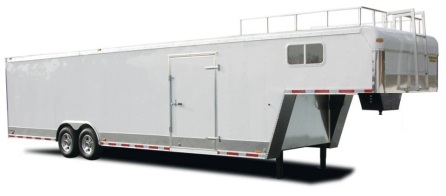
Not as much attention is given to balance, hitching procedures, and weight restrictions for fifth-wheel trailers because they are basically very stable. A disadvantage that the fifth-wheel has over conventional trailers is that much of the truck bed space is not available. The fifth-wheel hitch occupies the centre of the truck bed and the hitch pin is in front of the centre line of the tow vehicle's rear axle. Hitch weight of fifth-wheel trailers is usually around 20 percent of the trailer weight. Hitches are rated for up to 15,000 pounds of gross trailer weight. Here are some terms used to describe typical fifth-wheel hitch components:
- Fifth-wheel Plate: Unit that contains hitch plate, plate jaws, and handle (mounted in the truck bed).
- Handle: Device used to release or lock the plate jaws.
- Hitch Plate: The 'wheel' that allows the trailer to articulate.
- Pin: The connecting device attached to a fifth-wheel trailer (designed to fit into the plate jaws mounted in the truck bed).
- Pin Box: Structure attached to the bottom front section of the trailer frame (the pin is attached to the bottom).
- Plate Jaws: Holds the pin.
- Side Rails: Support rails, bolted to the tow truck bed (supports the fifth-wheel hitch).
Transporting Passengers
In most countries it is illegal to carry passengers in a trailer unless it is specifically designed for this purpose, i.e., an articulated bus. Regardless of the legal situation, it is not advisable to carry passengers in the trailer at any time! This includes moving the trailer around in the paddock.
Weighing the Trailer
Trailers should be carefully weighed to make sure that loads are properly distributed, front to rear as well as left to right. There are two additional considerations with trailer weights:
- The tow vehicle pulling the trailer and
- The hitching system that connects the two.
Both the tow vehicle and the hitching system have weight capacities which affect the safe handling of the vehicle. As the driver you should be aware of this.
- Tow Vehicle. Do not exceed the Recommended Gross Vehicle Weight of the tow vehicle. This includes the curb weight of the vehicle, payload, and hitch weight. This is the maximum weight the vehicle brakes are designed to stop.
- Hitch weight is the percentage of the trailer weight that is placed on the trailer coupler of the tow vehicle. Tow vehicles also have weight limits. Payload and hitch weight must be divided evenly between the axles to conform with the maximum weight limits and to avoid oversteering problems.
- Trailer Vehicle Hitch Weight. Approximately 10%-15% of a trailer's gross weight is designed to be loaded in front of the front axle and onto the hitching mechanism. This ensures needed stability for road handling. If the trailer is not stable, there may be a problem with not enough weight on the hitch. Here are some methods to figure out hitch weight:
=> Park the loaded trailer on a scale so that the hitch coupler extends beyond the end of the scale, but the tongue jack post (the post on the front of the trailer which rests on the ground when unhitched) is on the scale.
=> Block the trailer vehicle wheels, unhitch the tow vehicle and obtain a weight rating. This is the curb weight of the trailer vehicle alone.
=> Place a jack stand under the coupler (beyond the scale) so that the tongue jack post is supported off
=> Subtract the reading in #2 from the reading in #3 to obtain the hitch weight.
In any trailer, vehicle stability and safety can be affected by weight distribution.
If, for example, rear axle weight is low, it is best to load the heaviest supplies toward the rear. Keep heaviest supplies low, to keep the centre of gravity low and ensure best handling.
Remember what you learned about 'yaw inertia' and 'polar moment of inertia' in the Vehicle Dynamics class? They are just as important in the trailer as they are in the race car!
Hitch Adjustment
If the hitch weight is less than 10% of the gross trailer weight, you can compensate for some of this by loading heavy items such as tools and as far forward as possible. If a water tank is behind the axle(s), travel with as little water in the tank as possible to reduce weight in the rear. Trailers with water tanks located in front usually handle best when the tanks are full, because the water adds to hitch weight. 
Be sure that the spring bars of the load distributing hitch are rated high enough to handle the hitch weight of your trailer, plus a safety margin of at least 10%. Check for adequate rear suspension travel of the tow vehicle. This means that the vehicle sits relatively level prior to hitching the trailer.
Load-distributing hitches are designed to distribute the hitch weight relatively evenly to all axles of the tow vehicle and trailer. The tow vehicle and trailer should be in a level attitude in order for the hitch to do its job properly. Here is how to check:
- With the tow vehicle loaded for the trip, measure the distance between the vehicle and the ground at reference points, which you can establish, in front and rear. Keep the figures handy for later use.
- Hitch the trailer and adjust the tension on the spring bars so the tow vehicle remains at roughly the same attitude (i.e., if the rear drops 25mm after hitching, the front should also drop 25mm).
- Inspect the trailer to be sure it is level. If not, hitch ball height should be raised or lowered as necessary. You may need spring bars rated for more weight if you cannot keep the tow vehicle from sagging in the rear.
Safety chains are required for trailers. Safety chains are not required for fifth-wheel trailers. The purpose of safety chains is to prevent the trailer from separating from the tow vehicle in event of hitch failure such as a hitch ball that has loosened. The chains should be crossed in an 'X' fashion below the ball mount, with enough slack that they do not restrict turning or allow the coupler to hit the ground.
Breakaway switches may also be required for any trailer They are designed to activate trailer brakes if the trailer detaches from the tow vehicle. One end of the breakaway switch is attached to an electrical switch on the trailer frame and the other end is looped around a stationary hitch component on the tow vehicle. If the two vehicles become separated, the cable pulls a pin inside the breakaway switch and applies full power from the trailer battery to the trailer brakes.
The tow bar length on the trailer is generally twice the trailer wheel width but no more than six feet from the axle to the end of the tongue. Good design will allow for good sway control. If the towbar is too short, the trailer will tend to sway. If it is too long, the trailer will be sluggish and cut corners when turning.
Sway Control
You will have good trailer handling if the weight and hitch adjustments are correct. However, the coupling between a tow vehicle and trailer should also prevent side to side motion for optimum towing comfort and safety.
A sway control device should be included when the hitch is installed. This device helps give the tow vehicle and trailer a 'one-vehicle' feel.
If you detect sway in your trailer, stop and check to see if the load has shifted. Check for suspension problems and make sure the tyres and wheels are secure and inflated properly. Be sure the trailer hitch is secure. An adjustment in tyre air pressure or a slight increase in tongue weight may help.
Trailer Lights
Trailers are required to have reflectors, tail lights, brake, turn signal and license plate lights. Wide trailers must have clearance lights. Most trailer manufacturers comply with these requirements, however, it is up to you to be sure that all lights operate correctly and meet the requirements of any country you pass through.
Trailer Brakes
In most countries, brakes are required on a trailer having a gross weight of approx 750Kg. or more. Check the requirements in your country!
Usually the braking capacity on tow vehicles is good, however, it may not be good enough to safely stop the weight of your fully loaded trailer whilst maintaining good controllability. Most conventional and fifth-wheel trailers have electric brakes, activated by a controller in the tow vehicle. The controller automatically coordinates the tow vehicle and trailer braking so the two systems work together when the brake pedal is applied.
The controller can also be helpful in stabilizing a trailer that sways because of bad road conditions. Manually applying the trailer brakes by using the hand lever on the controller will settle a trailer that has a tendency to sway.
Small trailers are sometimes fitted with surge brake systems which operate separately from the tow vehicle's brakes. Surge brakes are applied by a mechanism attached to the receiver/ball connection. As the tow vehicle slows, the forward motion of the trailer compresses the mechanism which in turn applies the trailer brakes.
Trailer Backing
Backing a trailer can be frustrating for inexperienced owners. The most important item to remember is that the trailer will go in the opposite direction of the tow vehicle. It is helpful to have another person help you back the trailer.
Here are two methods for backing trailers:
- Turn the vehicle's wheels to the right to make the trailer go left, and vice versa.
- Put your hand at the bottom of the steering wheel. The trailer will go in the same direction your hand moves (moving your hand to the right will cause the trailer to go right, and vice versa).
Sharp steering wheel corrections will cause the trailer to 'jack-knife' and may cause damage to the rear of the tow vehicle or the front of the trailer.
Conclusion
I started this blog with a sad story about a student accident. The intent is to try ensure something like that never happens again.
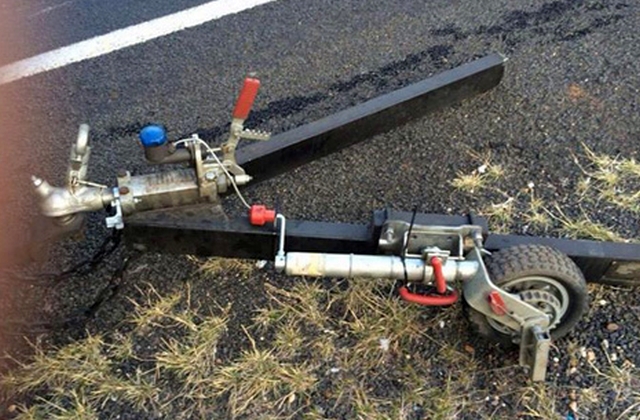
Please be sensible on your trip to Hockenheim. Red Bull and similar energy drinks are no substitute for sleep! Remember the old saying "It is better to be late than to be dead on time".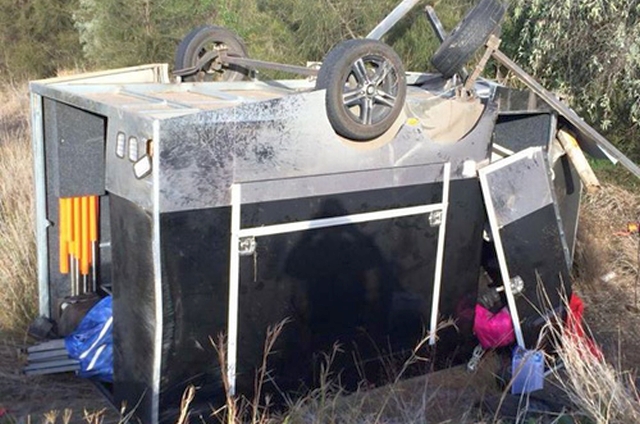
This aricle is based on the booklet "Towing Your Trailer Safely" by California Department of Motor Vehicles.
Design Error of the Month
I cannot finish without the traditional Design Error. I like to make sure the error relates to the blog article, so I had to troll the net to find something rather than search my archives.
This epitomises what the DEOTM represents. I like the note on the licence plate :-) No further comment is needed.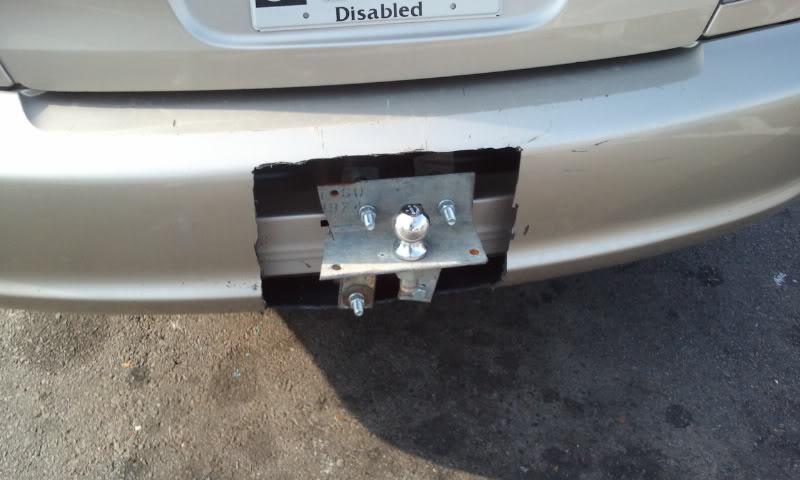
See you all next week! Drop in to say hello and join me for a coffee at 'Pat's Corner'.

Pat


